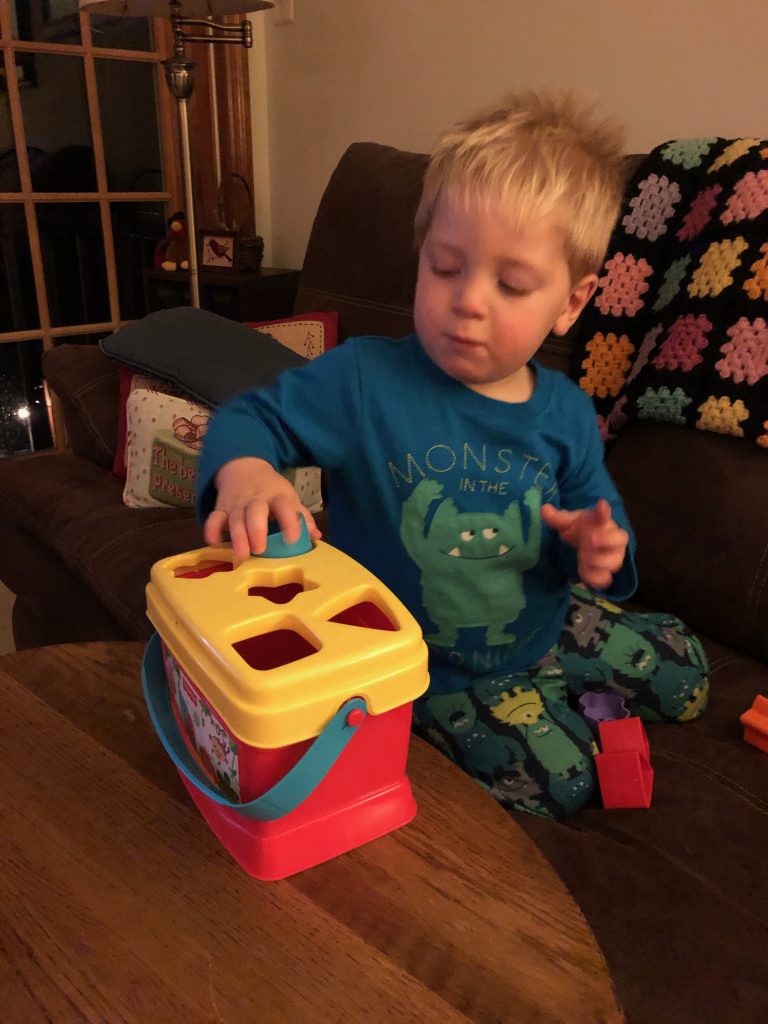
Shape Play
STEM Concepts: Science (observing), Math (shapes, sorting), Technology (tools, use of objects)
Materials: Square shaped objects from around the house (such as boxes, books, napkins, etc.), circle shaped objects such as a roll of tape, plates, lids to jars, etc), a large piece of paper with a line down the middle
What to do: Go around your house and collect random objects (toys, books, cooking supplies, tools such as rolls of tape, etc. items that are safe for children to handle) that are either square or circle in shape. Have your child help you draw a square on the right half of the construction paper and a circle on the left half. Have him sort the objects into groups of squares or circles, moving the square shaped objects to the square side of the paper and the same for the circle shaped objects. Once sorted, encourage him to count how many things are in each group. Ask him what you use the different objects for.
Language and Communication: Be sure to emphasize the names of the two shapes and use the word “sort” to explain putting things into different groups. When you ask your child the use of the different objects you’ve collected, she may give creative or unusual answers. Instead of telling her she is wrong, encourage her to use her creativity! Thinking outside the box is a useful skill to develop early on.
Expand the Activity: To expand this activity, go outside and collect things of different shapes in nature. Bringing the natural world into this activity can lead into discussions on nature and the outside world. You can also introduce the triangle or other simple shapes that can be found in your house. Another way to expand this activity is to provide paper and crayons for your child to draw the different shapes and objects.
Open and Shut Them
STEM Concepts: Science (physical science), Math (spatial relationships), Technology (simple machines, simple tools)
Materials: Toys with doors or latches that can be opened and shut. House-hold containers, your child’s bedroom door, books. There are a lot of toys out there with different doors and locks that you can teach your kids these great science and technology skills while building their fine motor development. NOTE: Some of the toys available for purchase for locks are suggested for children aged 3 and older. Although we recommend teaching open and shut to a child under the age of three, we do not suggest purchasing toys outside of your child’s age. If you purchase these items, use caution with toys suggested for older ages. These ages listed on toys are for their safety and typically are because the toy may contain small pieces that your child could choke on.
What to do: Set up an area where your child can open and shut the different items. It will be helpful for the child to see you model what you want them to do. So sitting down and putting lids back on containers to close them or opening a book will show the child they are able to manipulate different toys or items in front of them.
Language and Communication: Using the terms “open and close” are necessary for this activity. It will introduce the terms and concepts the more they hear it. “You closed the lid,” or “I am going to shut the door” will encourage your children to associate the terms with the actions.
Expand the Activity: This activity can be done during daily living. When leaving your home have your child help you shut the door. When returning, have them help you open the door.

